Contemporary Issues in Health & Social Care: Public Concerns
VerifiedAdded on 2023/02/02
|13
|4427
|67
Report
AI Summary
This report provides an in-depth analysis of contemporary issues in health and social care, focusing on public concerns, media influence, and service development. It examines how information related to health and social care gives rise to public concerns, particularly focusing on Female Genital Mutilation (FGM). The report assesses how the media presents these issues and influences public attitudes and behaviors, emphasizing the importance of verifying the reliability and validity of media information. Furthermore, it delves into different perspectives on FGM, analyzing the extent to which local attitudes reflect national trends and the validity of public attitudes and behaviors. The report also explores the impact of contemporary perspectives on the development of health services, highlighting the role of organizations like the World Health Organization and the need for increased awareness and preventative measures to combat issues like FGM. The study concludes by emphasizing the importance of changing societal thinking and improving healthcare policies to address these critical issues.
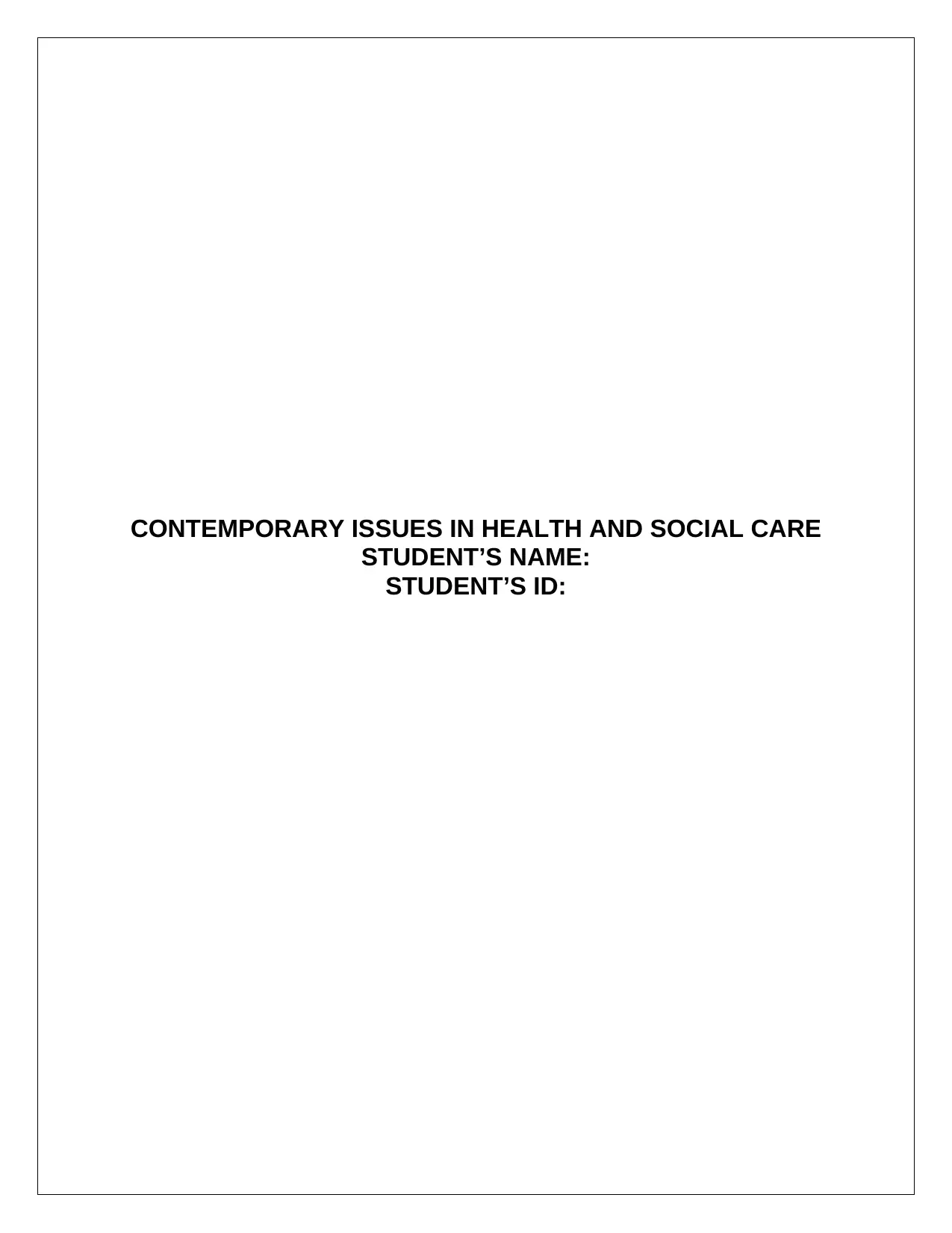
CONTEMPORARY ISSUES IN HEALTH AND SOCIAL CARE
STUDENT’S NAME:
STUDENT’S ID:
STUDENT’S NAME:
STUDENT’S ID:
Paraphrase This Document
Need a fresh take? Get an instant paraphrase of this document with our AI Paraphraser
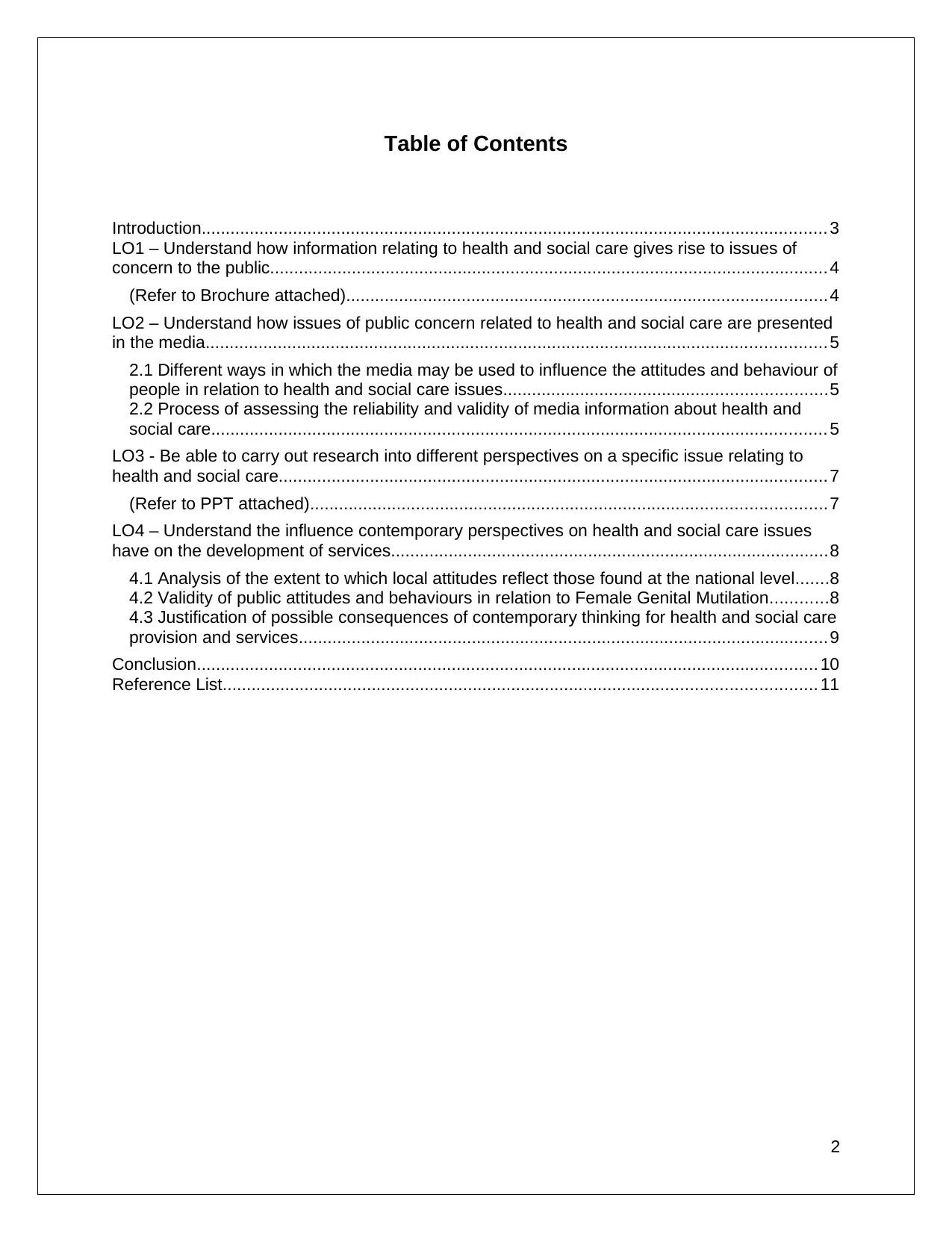
Table of Contents
Introduction.................................................................................................................................. 3
LO1 – Understand how information relating to health and social care gives rise to issues of
concern to the public.................................................................................................................... 4
(Refer to Brochure attached)....................................................................................................4
LO2 – Understand how issues of public concern related to health and social care are presented
in the media................................................................................................................................. 5
2.1 Different ways in which the media may be used to influence the attitudes and behaviour of
people in relation to health and social care issues...................................................................5
2.2 Process of assessing the reliability and validity of media information about health and
social care................................................................................................................................ 5
LO3 - Be able to carry out research into different perspectives on a specific issue relating to
health and social care.................................................................................................................. 7
(Refer to PPT attached)...........................................................................................................7
LO4 – Understand the influence contemporary perspectives on health and social care issues
have on the development of services...........................................................................................8
4.1 Analysis of the extent to which local attitudes reflect those found at the national level.......8
4.2 Validity of public attitudes and behaviours in relation to Female Genital Mutilation............8
4.3 Justification of possible consequences of contemporary thinking for health and social care
provision and services..............................................................................................................9
Conclusion................................................................................................................................. 10
Reference List........................................................................................................................... 11
2
Introduction.................................................................................................................................. 3
LO1 – Understand how information relating to health and social care gives rise to issues of
concern to the public.................................................................................................................... 4
(Refer to Brochure attached)....................................................................................................4
LO2 – Understand how issues of public concern related to health and social care are presented
in the media................................................................................................................................. 5
2.1 Different ways in which the media may be used to influence the attitudes and behaviour of
people in relation to health and social care issues...................................................................5
2.2 Process of assessing the reliability and validity of media information about health and
social care................................................................................................................................ 5
LO3 - Be able to carry out research into different perspectives on a specific issue relating to
health and social care.................................................................................................................. 7
(Refer to PPT attached)...........................................................................................................7
LO4 – Understand the influence contemporary perspectives on health and social care issues
have on the development of services...........................................................................................8
4.1 Analysis of the extent to which local attitudes reflect those found at the national level.......8
4.2 Validity of public attitudes and behaviours in relation to Female Genital Mutilation............8
4.3 Justification of possible consequences of contemporary thinking for health and social care
provision and services..............................................................................................................9
Conclusion................................................................................................................................. 10
Reference List........................................................................................................................... 11
2
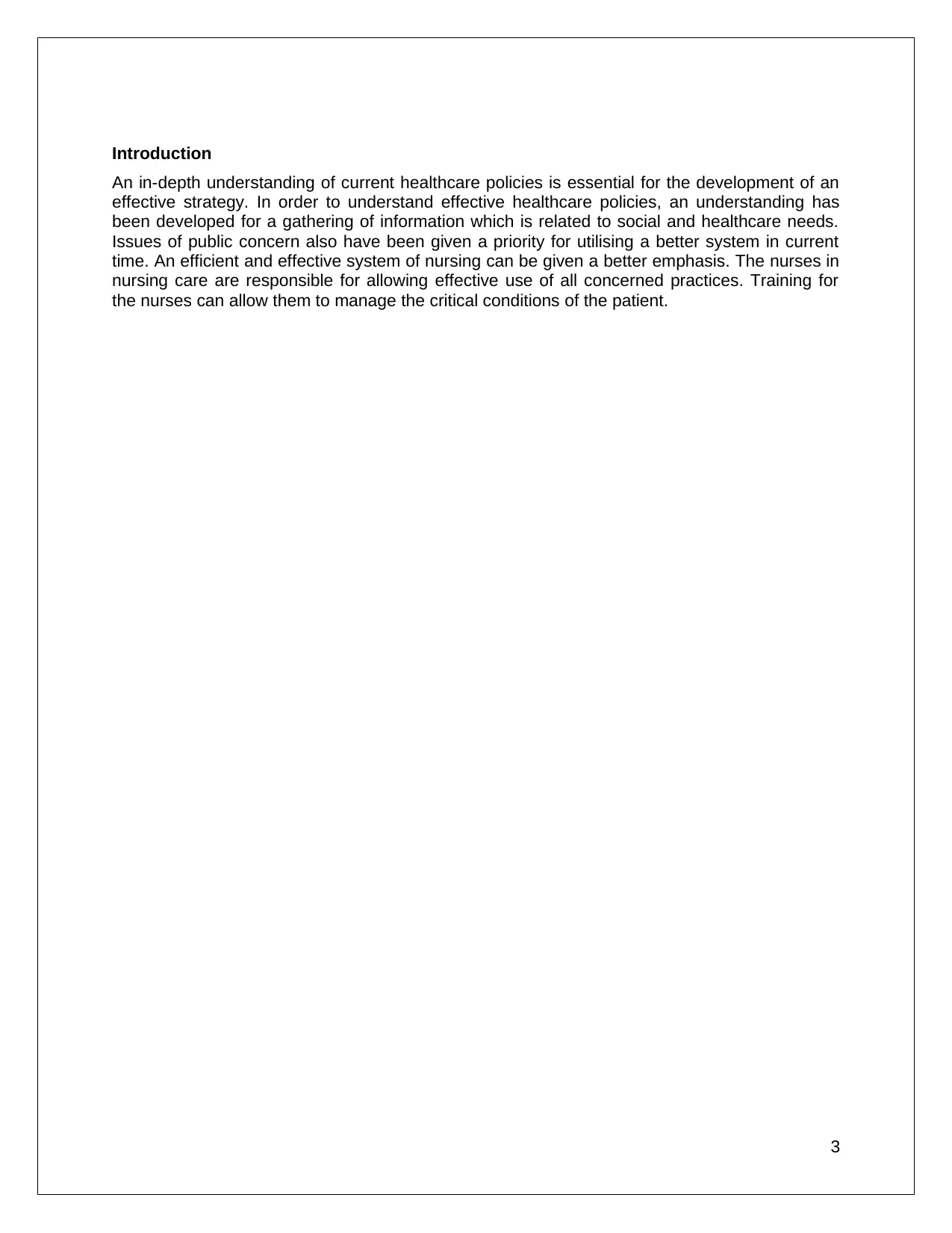
Introduction
An in-depth understanding of current healthcare policies is essential for the development of an
effective strategy. In order to understand effective healthcare policies, an understanding has
been developed for a gathering of information which is related to social and healthcare needs.
Issues of public concern also have been given a priority for utilising a better system in current
time. An efficient and effective system of nursing can be given a better emphasis. The nurses in
nursing care are responsible for allowing effective use of all concerned practices. Training for
the nurses can allow them to manage the critical conditions of the patient.
3
An in-depth understanding of current healthcare policies is essential for the development of an
effective strategy. In order to understand effective healthcare policies, an understanding has
been developed for a gathering of information which is related to social and healthcare needs.
Issues of public concern also have been given a priority for utilising a better system in current
time. An efficient and effective system of nursing can be given a better emphasis. The nurses in
nursing care are responsible for allowing effective use of all concerned practices. Training for
the nurses can allow them to manage the critical conditions of the patient.
3
⊘ This is a preview!⊘
Do you want full access?
Subscribe today to unlock all pages.

Trusted by 1+ million students worldwide
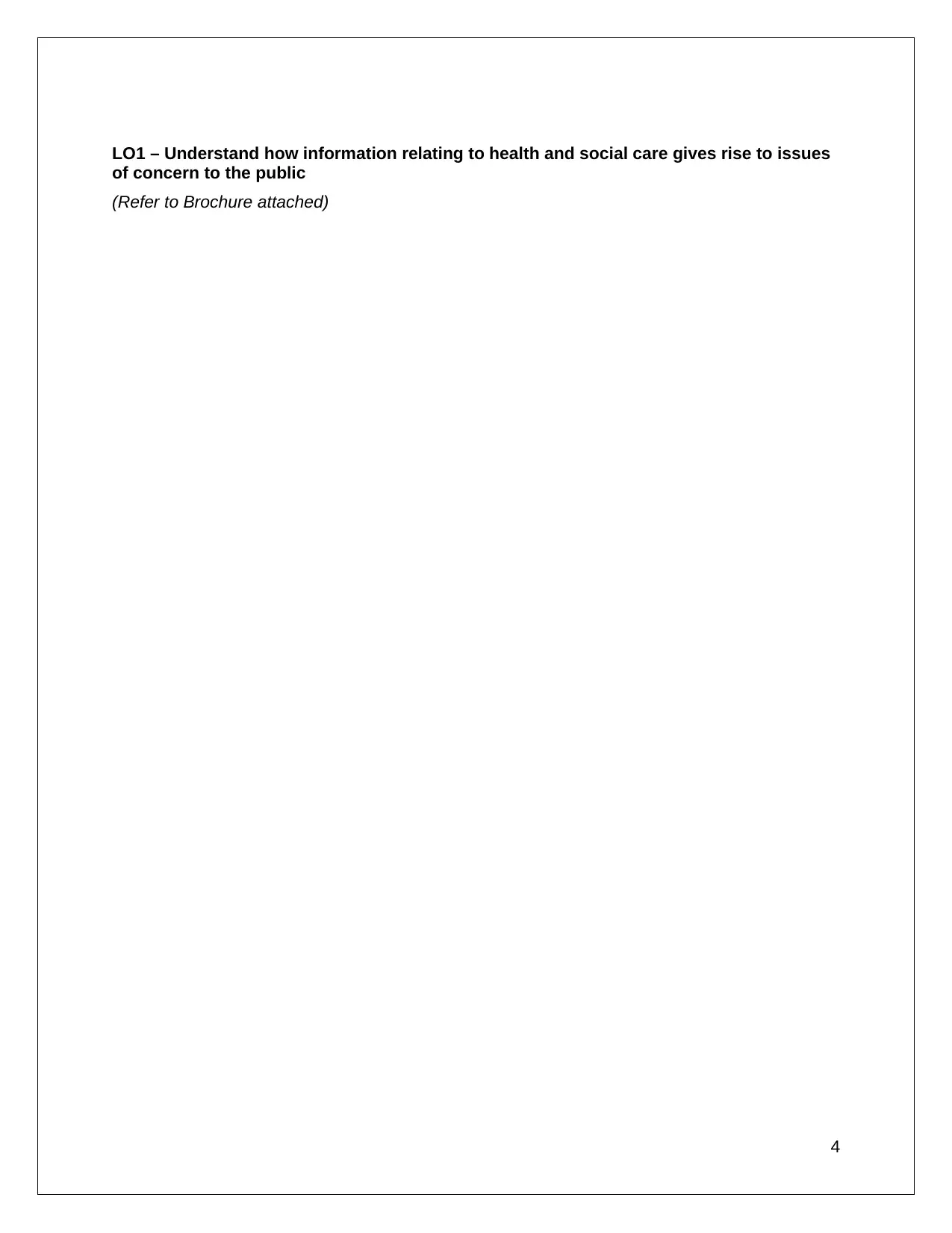
LO1 – Understand how information relating to health and social care gives rise to issues
of concern to the public
(Refer to Brochure attached)
4
of concern to the public
(Refer to Brochure attached)
4
Paraphrase This Document
Need a fresh take? Get an instant paraphrase of this document with our AI Paraphraser
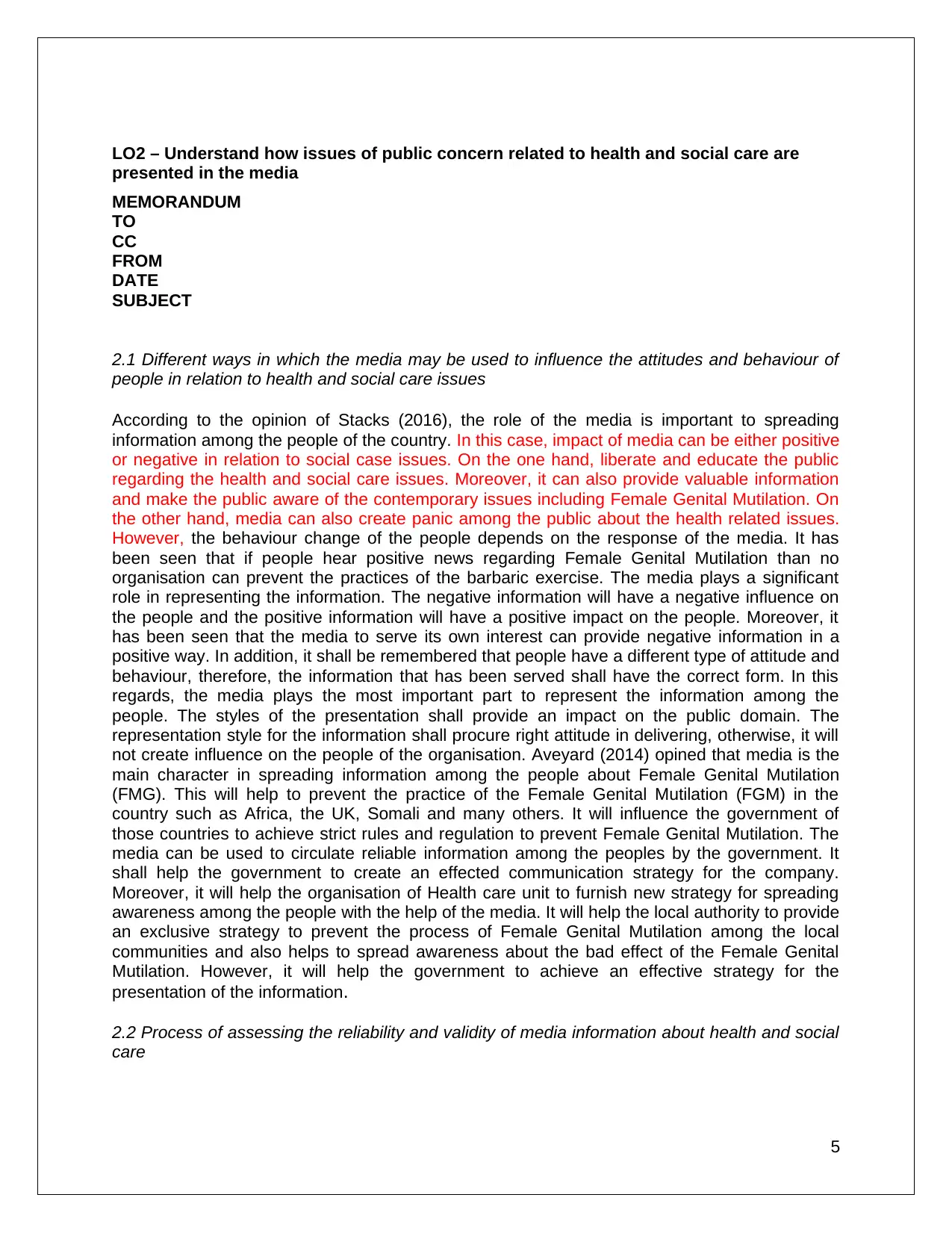
LO2 – Understand how issues of public concern related to health and social care are
presented in the media
MEMORANDUM
TO
CC
FROM
DATE
SUBJECT
2.1 Different ways in which the media may be used to influence the attitudes and behaviour of
people in relation to health and social care issues
According to the opinion of Stacks (2016), the role of the media is important to spreading
information among the people of the country. In this case, impact of media can be either positive
or negative in relation to social case issues. On the one hand, liberate and educate the public
regarding the health and social care issues. Moreover, it can also provide valuable information
and make the public aware of the contemporary issues including Female Genital Mutilation. On
the other hand, media can also create panic among the public about the health related issues.
However, the behaviour change of the people depends on the response of the media. It has
been seen that if people hear positive news regarding Female Genital Mutilation than no
organisation can prevent the practices of the barbaric exercise. The media plays a significant
role in representing the information. The negative information will have a negative influence on
the people and the positive information will have a positive impact on the people. Moreover, it
has been seen that the media to serve its own interest can provide negative information in a
positive way. In addition, it shall be remembered that people have a different type of attitude and
behaviour, therefore, the information that has been served shall have the correct form. In this
regards, the media plays the most important part to represent the information among the
people. The styles of the presentation shall provide an impact on the public domain. The
representation style for the information shall procure right attitude in delivering, otherwise, it will
not create influence on the people of the organisation. Aveyard (2014) opined that media is the
main character in spreading information among the people about Female Genital Mutilation
(FMG). This will help to prevent the practice of the Female Genital Mutilation (FGM) in the
country such as Africa, the UK, Somali and many others. It will influence the government of
those countries to achieve strict rules and regulation to prevent Female Genital Mutilation. The
media can be used to circulate reliable information among the peoples by the government. It
shall help the government to create an effected communication strategy for the company.
Moreover, it will help the organisation of Health care unit to furnish new strategy for spreading
awareness among the people with the help of the media. It will help the local authority to provide
an exclusive strategy to prevent the process of Female Genital Mutilation among the local
communities and also helps to spread awareness about the bad effect of the Female Genital
Mutilation. However, it will help the government to achieve an effective strategy for the
presentation of the information.
2.2 Process of assessing the reliability and validity of media information about health and social
care
5
presented in the media
MEMORANDUM
TO
CC
FROM
DATE
SUBJECT
2.1 Different ways in which the media may be used to influence the attitudes and behaviour of
people in relation to health and social care issues
According to the opinion of Stacks (2016), the role of the media is important to spreading
information among the people of the country. In this case, impact of media can be either positive
or negative in relation to social case issues. On the one hand, liberate and educate the public
regarding the health and social care issues. Moreover, it can also provide valuable information
and make the public aware of the contemporary issues including Female Genital Mutilation. On
the other hand, media can also create panic among the public about the health related issues.
However, the behaviour change of the people depends on the response of the media. It has
been seen that if people hear positive news regarding Female Genital Mutilation than no
organisation can prevent the practices of the barbaric exercise. The media plays a significant
role in representing the information. The negative information will have a negative influence on
the people and the positive information will have a positive impact on the people. Moreover, it
has been seen that the media to serve its own interest can provide negative information in a
positive way. In addition, it shall be remembered that people have a different type of attitude and
behaviour, therefore, the information that has been served shall have the correct form. In this
regards, the media plays the most important part to represent the information among the
people. The styles of the presentation shall provide an impact on the public domain. The
representation style for the information shall procure right attitude in delivering, otherwise, it will
not create influence on the people of the organisation. Aveyard (2014) opined that media is the
main character in spreading information among the people about Female Genital Mutilation
(FMG). This will help to prevent the practice of the Female Genital Mutilation (FGM) in the
country such as Africa, the UK, Somali and many others. It will influence the government of
those countries to achieve strict rules and regulation to prevent Female Genital Mutilation. The
media can be used to circulate reliable information among the peoples by the government. It
shall help the government to create an effected communication strategy for the company.
Moreover, it will help the organisation of Health care unit to furnish new strategy for spreading
awareness among the people with the help of the media. It will help the local authority to provide
an exclusive strategy to prevent the process of Female Genital Mutilation among the local
communities and also helps to spread awareness about the bad effect of the Female Genital
Mutilation. However, it will help the government to achieve an effective strategy for the
presentation of the information.
2.2 Process of assessing the reliability and validity of media information about health and social
care
5
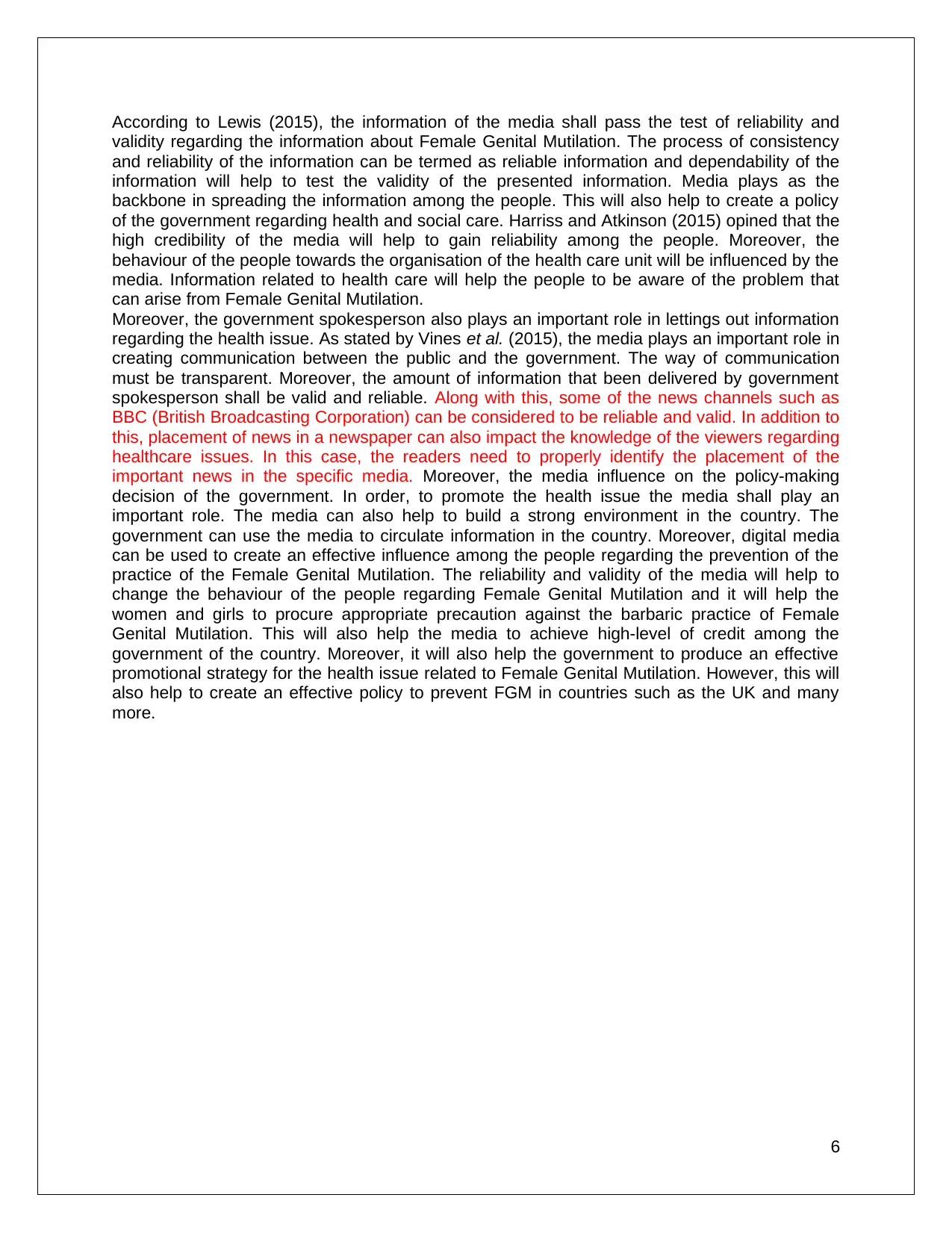
According to Lewis (2015), the information of the media shall pass the test of reliability and
validity regarding the information about Female Genital Mutilation. The process of consistency
and reliability of the information can be termed as reliable information and dependability of the
information will help to test the validity of the presented information. Media plays as the
backbone in spreading the information among the people. This will also help to create a policy
of the government regarding health and social care. Harriss and Atkinson (2015) opined that the
high credibility of the media will help to gain reliability among the people. Moreover, the
behaviour of the people towards the organisation of the health care unit will be influenced by the
media. Information related to health care will help the people to be aware of the problem that
can arise from Female Genital Mutilation.
Moreover, the government spokesperson also plays an important role in lettings out information
regarding the health issue. As stated by Vines et al. (2015), the media plays an important role in
creating communication between the public and the government. The way of communication
must be transparent. Moreover, the amount of information that been delivered by government
spokesperson shall be valid and reliable. Along with this, some of the news channels such as
BBC (British Broadcasting Corporation) can be considered to be reliable and valid. In addition to
this, placement of news in a newspaper can also impact the knowledge of the viewers regarding
healthcare issues. In this case, the readers need to properly identify the placement of the
important news in the specific media. Moreover, the media influence on the policy-making
decision of the government. In order, to promote the health issue the media shall play an
important role. The media can also help to build a strong environment in the country. The
government can use the media to circulate information in the country. Moreover, digital media
can be used to create an effective influence among the people regarding the prevention of the
practice of the Female Genital Mutilation. The reliability and validity of the media will help to
change the behaviour of the people regarding Female Genital Mutilation and it will help the
women and girls to procure appropriate precaution against the barbaric practice of Female
Genital Mutilation. This will also help the media to achieve high-level of credit among the
government of the country. Moreover, it will also help the government to produce an effective
promotional strategy for the health issue related to Female Genital Mutilation. However, this will
also help to create an effective policy to prevent FGM in countries such as the UK and many
more.
6
validity regarding the information about Female Genital Mutilation. The process of consistency
and reliability of the information can be termed as reliable information and dependability of the
information will help to test the validity of the presented information. Media plays as the
backbone in spreading the information among the people. This will also help to create a policy
of the government regarding health and social care. Harriss and Atkinson (2015) opined that the
high credibility of the media will help to gain reliability among the people. Moreover, the
behaviour of the people towards the organisation of the health care unit will be influenced by the
media. Information related to health care will help the people to be aware of the problem that
can arise from Female Genital Mutilation.
Moreover, the government spokesperson also plays an important role in lettings out information
regarding the health issue. As stated by Vines et al. (2015), the media plays an important role in
creating communication between the public and the government. The way of communication
must be transparent. Moreover, the amount of information that been delivered by government
spokesperson shall be valid and reliable. Along with this, some of the news channels such as
BBC (British Broadcasting Corporation) can be considered to be reliable and valid. In addition to
this, placement of news in a newspaper can also impact the knowledge of the viewers regarding
healthcare issues. In this case, the readers need to properly identify the placement of the
important news in the specific media. Moreover, the media influence on the policy-making
decision of the government. In order, to promote the health issue the media shall play an
important role. The media can also help to build a strong environment in the country. The
government can use the media to circulate information in the country. Moreover, digital media
can be used to create an effective influence among the people regarding the prevention of the
practice of the Female Genital Mutilation. The reliability and validity of the media will help to
change the behaviour of the people regarding Female Genital Mutilation and it will help the
women and girls to procure appropriate precaution against the barbaric practice of Female
Genital Mutilation. This will also help the media to achieve high-level of credit among the
government of the country. Moreover, it will also help the government to produce an effective
promotional strategy for the health issue related to Female Genital Mutilation. However, this will
also help to create an effective policy to prevent FGM in countries such as the UK and many
more.
6
⊘ This is a preview!⊘
Do you want full access?
Subscribe today to unlock all pages.

Trusted by 1+ million students worldwide
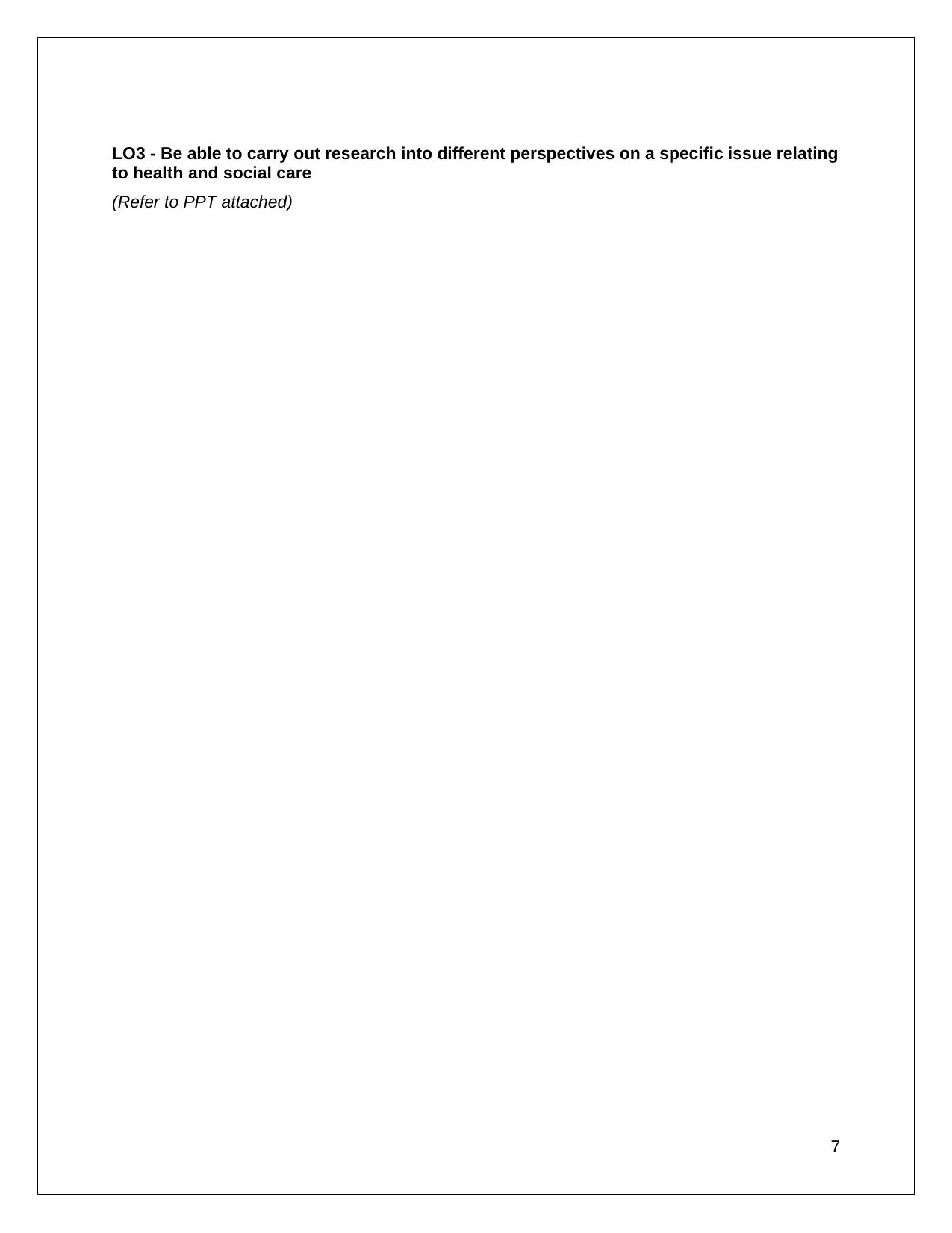
LO3 - Be able to carry out research into different perspectives on a specific issue relating
to health and social care
(Refer to PPT attached)
7
to health and social care
(Refer to PPT attached)
7
Paraphrase This Document
Need a fresh take? Get an instant paraphrase of this document with our AI Paraphraser
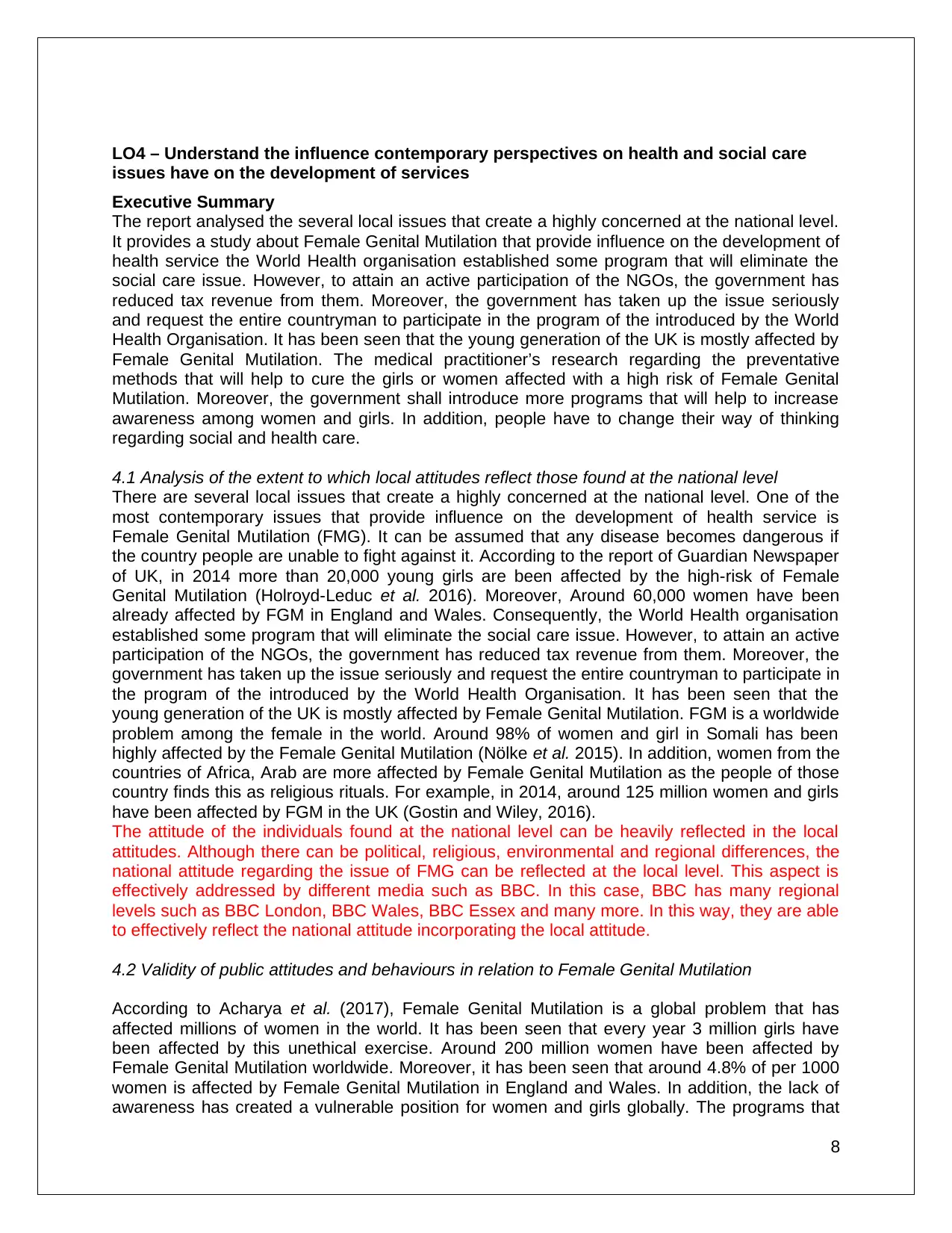
LO4 – Understand the influence contemporary perspectives on health and social care
issues have on the development of services
Executive Summary
The report analysed the several local issues that create a highly concerned at the national level.
It provides a study about Female Genital Mutilation that provide influence on the development of
health service the World Health organisation established some program that will eliminate the
social care issue. However, to attain an active participation of the NGOs, the government has
reduced tax revenue from them. Moreover, the government has taken up the issue seriously
and request the entire countryman to participate in the program of the introduced by the World
Health Organisation. It has been seen that the young generation of the UK is mostly affected by
Female Genital Mutilation. The medical practitioner’s research regarding the preventative
methods that will help to cure the girls or women affected with a high risk of Female Genital
Mutilation. Moreover, the government shall introduce more programs that will help to increase
awareness among women and girls. In addition, people have to change their way of thinking
regarding social and health care.
4.1 Analysis of the extent to which local attitudes reflect those found at the national level
There are several local issues that create a highly concerned at the national level. One of the
most contemporary issues that provide influence on the development of health service is
Female Genital Mutilation (FMG). It can be assumed that any disease becomes dangerous if
the country people are unable to fight against it. According to the report of Guardian Newspaper
of UK, in 2014 more than 20,000 young girls are been affected by the high-risk of Female
Genital Mutilation (Holroyd-Leduc et al. 2016). Moreover, Around 60,000 women have been
already affected by FGM in England and Wales. Consequently, the World Health organisation
established some program that will eliminate the social care issue. However, to attain an active
participation of the NGOs, the government has reduced tax revenue from them. Moreover, the
government has taken up the issue seriously and request the entire countryman to participate in
the program of the introduced by the World Health Organisation. It has been seen that the
young generation of the UK is mostly affected by Female Genital Mutilation. FGM is a worldwide
problem among the female in the world. Around 98% of women and girl in Somali has been
highly affected by the Female Genital Mutilation (Nölke et al. 2015). In addition, women from the
countries of Africa, Arab are more affected by Female Genital Mutilation as the people of those
country finds this as religious rituals. For example, in 2014, around 125 million women and girls
have been affected by FGM in the UK (Gostin and Wiley, 2016).
The attitude of the individuals found at the national level can be heavily reflected in the local
attitudes. Although there can be political, religious, environmental and regional differences, the
national attitude regarding the issue of FMG can be reflected at the local level. This aspect is
effectively addressed by different media such as BBC. In this case, BBC has many regional
levels such as BBC London, BBC Wales, BBC Essex and many more. In this way, they are able
to effectively reflect the national attitude incorporating the local attitude.
4.2 Validity of public attitudes and behaviours in relation to Female Genital Mutilation
According to Acharya et al. (2017), Female Genital Mutilation is a global problem that has
affected millions of women in the world. It has been seen that every year 3 million girls have
been affected by this unethical exercise. Around 200 million women have been affected by
Female Genital Mutilation worldwide. Moreover, it has been seen that around 4.8% of per 1000
women is affected by Female Genital Mutilation in England and Wales. In addition, the lack of
awareness has created a vulnerable position for women and girls globally. The programs that
8
issues have on the development of services
Executive Summary
The report analysed the several local issues that create a highly concerned at the national level.
It provides a study about Female Genital Mutilation that provide influence on the development of
health service the World Health organisation established some program that will eliminate the
social care issue. However, to attain an active participation of the NGOs, the government has
reduced tax revenue from them. Moreover, the government has taken up the issue seriously
and request the entire countryman to participate in the program of the introduced by the World
Health Organisation. It has been seen that the young generation of the UK is mostly affected by
Female Genital Mutilation. The medical practitioner’s research regarding the preventative
methods that will help to cure the girls or women affected with a high risk of Female Genital
Mutilation. Moreover, the government shall introduce more programs that will help to increase
awareness among women and girls. In addition, people have to change their way of thinking
regarding social and health care.
4.1 Analysis of the extent to which local attitudes reflect those found at the national level
There are several local issues that create a highly concerned at the national level. One of the
most contemporary issues that provide influence on the development of health service is
Female Genital Mutilation (FMG). It can be assumed that any disease becomes dangerous if
the country people are unable to fight against it. According to the report of Guardian Newspaper
of UK, in 2014 more than 20,000 young girls are been affected by the high-risk of Female
Genital Mutilation (Holroyd-Leduc et al. 2016). Moreover, Around 60,000 women have been
already affected by FGM in England and Wales. Consequently, the World Health organisation
established some program that will eliminate the social care issue. However, to attain an active
participation of the NGOs, the government has reduced tax revenue from them. Moreover, the
government has taken up the issue seriously and request the entire countryman to participate in
the program of the introduced by the World Health Organisation. It has been seen that the
young generation of the UK is mostly affected by Female Genital Mutilation. FGM is a worldwide
problem among the female in the world. Around 98% of women and girl in Somali has been
highly affected by the Female Genital Mutilation (Nölke et al. 2015). In addition, women from the
countries of Africa, Arab are more affected by Female Genital Mutilation as the people of those
country finds this as religious rituals. For example, in 2014, around 125 million women and girls
have been affected by FGM in the UK (Gostin and Wiley, 2016).
The attitude of the individuals found at the national level can be heavily reflected in the local
attitudes. Although there can be political, religious, environmental and regional differences, the
national attitude regarding the issue of FMG can be reflected at the local level. This aspect is
effectively addressed by different media such as BBC. In this case, BBC has many regional
levels such as BBC London, BBC Wales, BBC Essex and many more. In this way, they are able
to effectively reflect the national attitude incorporating the local attitude.
4.2 Validity of public attitudes and behaviours in relation to Female Genital Mutilation
According to Acharya et al. (2017), Female Genital Mutilation is a global problem that has
affected millions of women in the world. It has been seen that every year 3 million girls have
been affected by this unethical exercise. Around 200 million women have been affected by
Female Genital Mutilation worldwide. Moreover, it has been seen that around 4.8% of per 1000
women is affected by Female Genital Mutilation in England and Wales. In addition, the lack of
awareness has created a vulnerable position for women and girls globally. The programs that
8
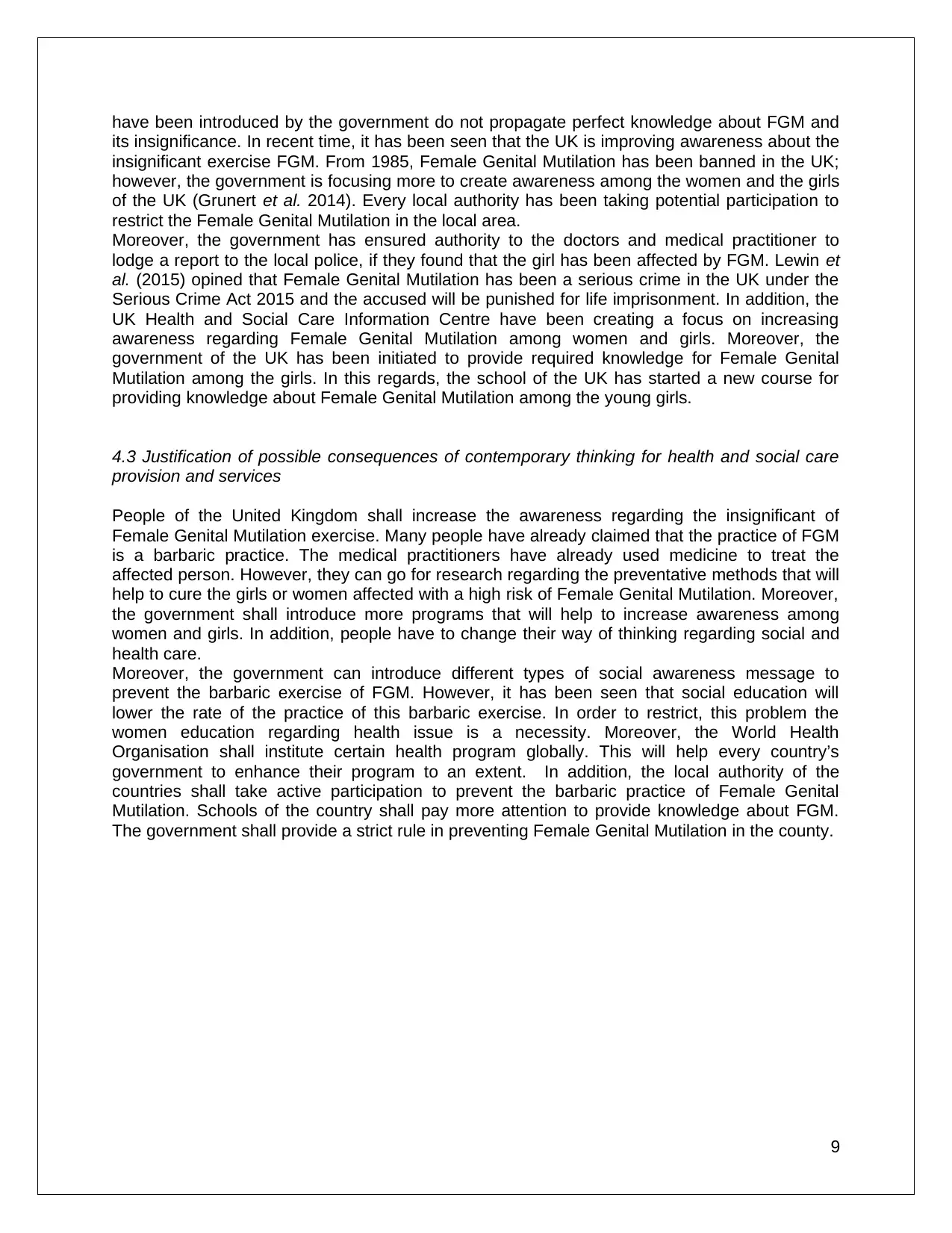
have been introduced by the government do not propagate perfect knowledge about FGM and
its insignificance. In recent time, it has been seen that the UK is improving awareness about the
insignificant exercise FGM. From 1985, Female Genital Mutilation has been banned in the UK;
however, the government is focusing more to create awareness among the women and the girls
of the UK (Grunert et al. 2014). Every local authority has been taking potential participation to
restrict the Female Genital Mutilation in the local area.
Moreover, the government has ensured authority to the doctors and medical practitioner to
lodge a report to the local police, if they found that the girl has been affected by FGM. Lewin et
al. (2015) opined that Female Genital Mutilation has been a serious crime in the UK under the
Serious Crime Act 2015 and the accused will be punished for life imprisonment. In addition, the
UK Health and Social Care Information Centre have been creating a focus on increasing
awareness regarding Female Genital Mutilation among women and girls. Moreover, the
government of the UK has been initiated to provide required knowledge for Female Genital
Mutilation among the girls. In this regards, the school of the UK has started a new course for
providing knowledge about Female Genital Mutilation among the young girls.
4.3 Justification of possible consequences of contemporary thinking for health and social care
provision and services
People of the United Kingdom shall increase the awareness regarding the insignificant of
Female Genital Mutilation exercise. Many people have already claimed that the practice of FGM
is a barbaric practice. The medical practitioners have already used medicine to treat the
affected person. However, they can go for research regarding the preventative methods that will
help to cure the girls or women affected with a high risk of Female Genital Mutilation. Moreover,
the government shall introduce more programs that will help to increase awareness among
women and girls. In addition, people have to change their way of thinking regarding social and
health care.
Moreover, the government can introduce different types of social awareness message to
prevent the barbaric exercise of FGM. However, it has been seen that social education will
lower the rate of the practice of this barbaric exercise. In order to restrict, this problem the
women education regarding health issue is a necessity. Moreover, the World Health
Organisation shall institute certain health program globally. This will help every country’s
government to enhance their program to an extent. In addition, the local authority of the
countries shall take active participation to prevent the barbaric practice of Female Genital
Mutilation. Schools of the country shall pay more attention to provide knowledge about FGM.
The government shall provide a strict rule in preventing Female Genital Mutilation in the county.
9
its insignificance. In recent time, it has been seen that the UK is improving awareness about the
insignificant exercise FGM. From 1985, Female Genital Mutilation has been banned in the UK;
however, the government is focusing more to create awareness among the women and the girls
of the UK (Grunert et al. 2014). Every local authority has been taking potential participation to
restrict the Female Genital Mutilation in the local area.
Moreover, the government has ensured authority to the doctors and medical practitioner to
lodge a report to the local police, if they found that the girl has been affected by FGM. Lewin et
al. (2015) opined that Female Genital Mutilation has been a serious crime in the UK under the
Serious Crime Act 2015 and the accused will be punished for life imprisonment. In addition, the
UK Health and Social Care Information Centre have been creating a focus on increasing
awareness regarding Female Genital Mutilation among women and girls. Moreover, the
government of the UK has been initiated to provide required knowledge for Female Genital
Mutilation among the girls. In this regards, the school of the UK has started a new course for
providing knowledge about Female Genital Mutilation among the young girls.
4.3 Justification of possible consequences of contemporary thinking for health and social care
provision and services
People of the United Kingdom shall increase the awareness regarding the insignificant of
Female Genital Mutilation exercise. Many people have already claimed that the practice of FGM
is a barbaric practice. The medical practitioners have already used medicine to treat the
affected person. However, they can go for research regarding the preventative methods that will
help to cure the girls or women affected with a high risk of Female Genital Mutilation. Moreover,
the government shall introduce more programs that will help to increase awareness among
women and girls. In addition, people have to change their way of thinking regarding social and
health care.
Moreover, the government can introduce different types of social awareness message to
prevent the barbaric exercise of FGM. However, it has been seen that social education will
lower the rate of the practice of this barbaric exercise. In order to restrict, this problem the
women education regarding health issue is a necessity. Moreover, the World Health
Organisation shall institute certain health program globally. This will help every country’s
government to enhance their program to an extent. In addition, the local authority of the
countries shall take active participation to prevent the barbaric practice of Female Genital
Mutilation. Schools of the country shall pay more attention to provide knowledge about FGM.
The government shall provide a strict rule in preventing Female Genital Mutilation in the county.
9
⊘ This is a preview!⊘
Do you want full access?
Subscribe today to unlock all pages.

Trusted by 1+ million students worldwide
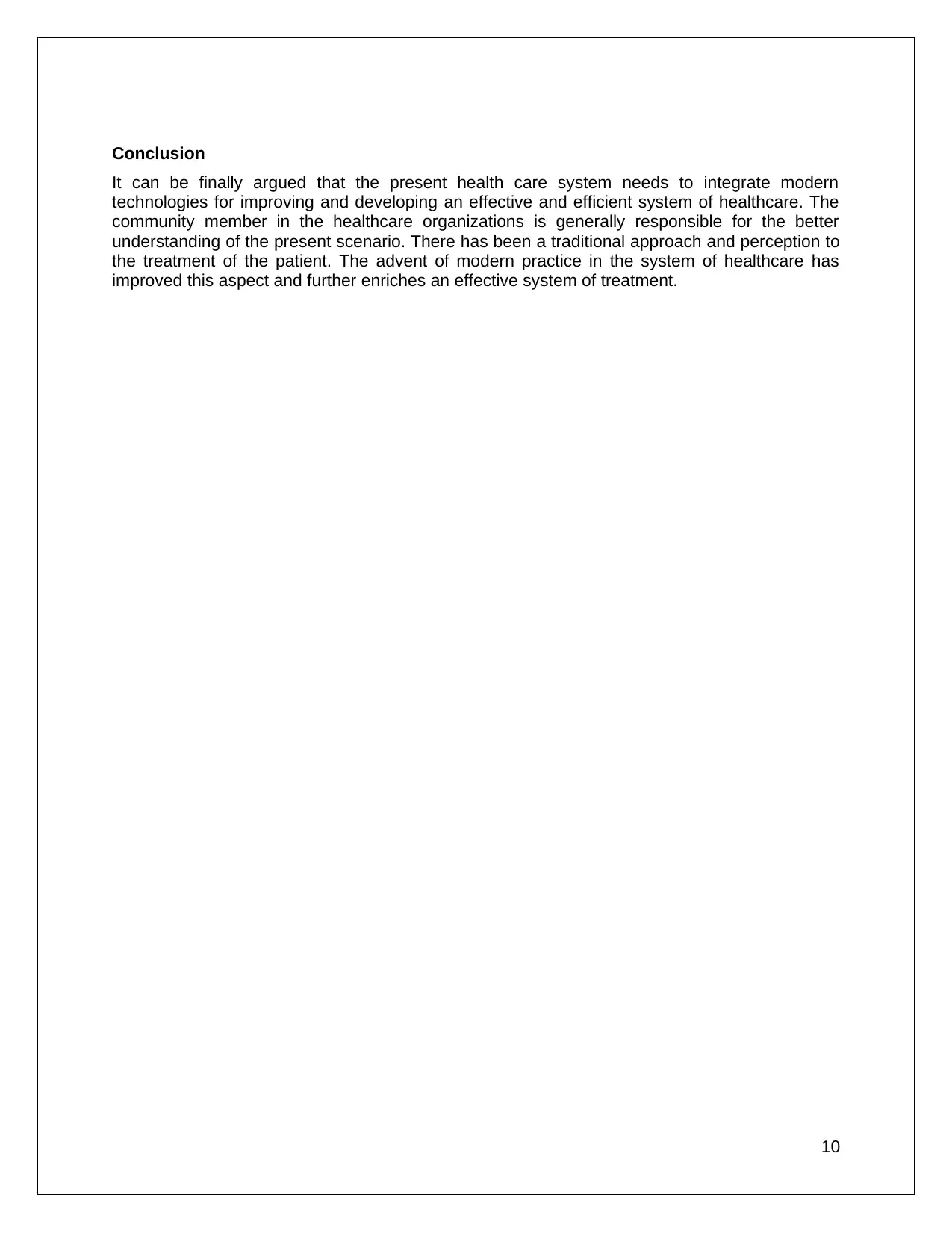
Conclusion
It can be finally argued that the present health care system needs to integrate modern
technologies for improving and developing an effective and efficient system of healthcare. The
community member in the healthcare organizations is generally responsible for the better
understanding of the present scenario. There has been a traditional approach and perception to
the treatment of the patient. The advent of modern practice in the system of healthcare has
improved this aspect and further enriches an effective system of treatment.
10
It can be finally argued that the present health care system needs to integrate modern
technologies for improving and developing an effective and efficient system of healthcare. The
community member in the healthcare organizations is generally responsible for the better
understanding of the present scenario. There has been a traditional approach and perception to
the treatment of the patient. The advent of modern practice in the system of healthcare has
improved this aspect and further enriches an effective system of treatment.
10
Paraphrase This Document
Need a fresh take? Get an instant paraphrase of this document with our AI Paraphraser
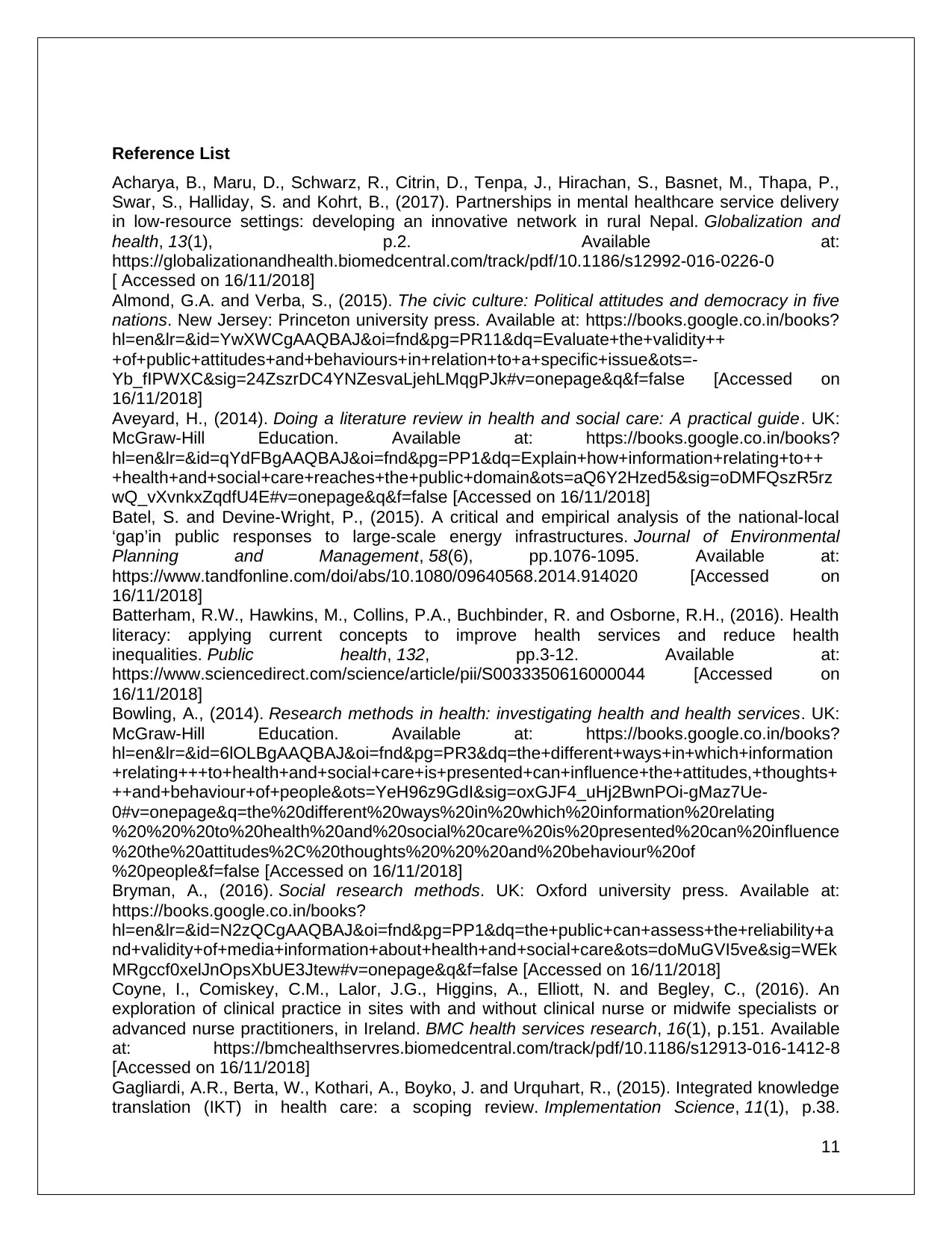
Reference List
Acharya, B., Maru, D., Schwarz, R., Citrin, D., Tenpa, J., Hirachan, S., Basnet, M., Thapa, P.,
Swar, S., Halliday, S. and Kohrt, B., (2017). Partnerships in mental healthcare service delivery
in low-resource settings: developing an innovative network in rural Nepal. Globalization and
health, 13(1), p.2. Available at:
https://globalizationandhealth.biomedcentral.com/track/pdf/10.1186/s12992-016-0226-0
[ Accessed on 16/11/2018]
Almond, G.A. and Verba, S., (2015). The civic culture: Political attitudes and democracy in five
nations. New Jersey: Princeton university press. Available at: https://books.google.co.in/books?
hl=en&lr=&id=YwXWCgAAQBAJ&oi=fnd&pg=PR11&dq=Evaluate+the+validity++
+of+public+attitudes+and+behaviours+in+relation+to+a+specific+issue&ots=-
Yb_fIPWXC&sig=24ZszrDC4YNZesvaLjehLMqgPJk#v=onepage&q&f=false [Accessed on
16/11/2018]
Aveyard, H., (2014). Doing a literature review in health and social care: A practical guide. UK:
McGraw-Hill Education. Available at: https://books.google.co.in/books?
hl=en&lr=&id=qYdFBgAAQBAJ&oi=fnd&pg=PP1&dq=Explain+how+information+relating+to++
+health+and+social+care+reaches+the+public+domain&ots=aQ6Y2Hzed5&sig=oDMFQszR5rz
wQ_vXvnkxZqdfU4E#v=onepage&q&f=false [Accessed on 16/11/2018]
Batel, S. and Devine-Wright, P., (2015). A critical and empirical analysis of the national-local
‘gap’in public responses to large-scale energy infrastructures. Journal of Environmental
Planning and Management, 58(6), pp.1076-1095. Available at:
https://www.tandfonline.com/doi/abs/10.1080/09640568.2014.914020 [Accessed on
16/11/2018]
Batterham, R.W., Hawkins, M., Collins, P.A., Buchbinder, R. and Osborne, R.H., (2016). Health
literacy: applying current concepts to improve health services and reduce health
inequalities. Public health, 132, pp.3-12. Available at:
https://www.sciencedirect.com/science/article/pii/S0033350616000044 [Accessed on
16/11/2018]
Bowling, A., (2014). Research methods in health: investigating health and health services. UK:
McGraw-Hill Education. Available at: https://books.google.co.in/books?
hl=en&lr=&id=6lOLBgAAQBAJ&oi=fnd&pg=PR3&dq=the+different+ways+in+which+information
+relating+++to+health+and+social+care+is+presented+can+influence+the+attitudes,+thoughts+
++and+behaviour+of+people&ots=YeH96z9GdI&sig=oxGJF4_uHj2BwnPOi-gMaz7Ue-
0#v=onepage&q=the%20different%20ways%20in%20which%20information%20relating
%20%20%20to%20health%20and%20social%20care%20is%20presented%20can%20influence
%20the%20attitudes%2C%20thoughts%20%20%20and%20behaviour%20of
%20people&f=false [Accessed on 16/11/2018]
Bryman, A., (2016). Social research methods. UK: Oxford university press. Available at:
https://books.google.co.in/books?
hl=en&lr=&id=N2zQCgAAQBAJ&oi=fnd&pg=PP1&dq=the+public+can+assess+the+reliability+a
nd+validity+of+media+information+about+health+and+social+care&ots=doMuGVI5ve&sig=WEk
MRgccf0xelJnOpsXbUE3Jtew#v=onepage&q&f=false [Accessed on 16/11/2018]
Coyne, I., Comiskey, C.M., Lalor, J.G., Higgins, A., Elliott, N. and Begley, C., (2016). An
exploration of clinical practice in sites with and without clinical nurse or midwife specialists or
advanced nurse practitioners, in Ireland. BMC health services research, 16(1), p.151. Available
at: https://bmchealthservres.biomedcentral.com/track/pdf/10.1186/s12913-016-1412-8
[Accessed on 16/11/2018]
Gagliardi, A.R., Berta, W., Kothari, A., Boyko, J. and Urquhart, R., (2015). Integrated knowledge
translation (IKT) in health care: a scoping review. Implementation Science, 11(1), p.38.
11
Acharya, B., Maru, D., Schwarz, R., Citrin, D., Tenpa, J., Hirachan, S., Basnet, M., Thapa, P.,
Swar, S., Halliday, S. and Kohrt, B., (2017). Partnerships in mental healthcare service delivery
in low-resource settings: developing an innovative network in rural Nepal. Globalization and
health, 13(1), p.2. Available at:
https://globalizationandhealth.biomedcentral.com/track/pdf/10.1186/s12992-016-0226-0
[ Accessed on 16/11/2018]
Almond, G.A. and Verba, S., (2015). The civic culture: Political attitudes and democracy in five
nations. New Jersey: Princeton university press. Available at: https://books.google.co.in/books?
hl=en&lr=&id=YwXWCgAAQBAJ&oi=fnd&pg=PR11&dq=Evaluate+the+validity++
+of+public+attitudes+and+behaviours+in+relation+to+a+specific+issue&ots=-
Yb_fIPWXC&sig=24ZszrDC4YNZesvaLjehLMqgPJk#v=onepage&q&f=false [Accessed on
16/11/2018]
Aveyard, H., (2014). Doing a literature review in health and social care: A practical guide. UK:
McGraw-Hill Education. Available at: https://books.google.co.in/books?
hl=en&lr=&id=qYdFBgAAQBAJ&oi=fnd&pg=PP1&dq=Explain+how+information+relating+to++
+health+and+social+care+reaches+the+public+domain&ots=aQ6Y2Hzed5&sig=oDMFQszR5rz
wQ_vXvnkxZqdfU4E#v=onepage&q&f=false [Accessed on 16/11/2018]
Batel, S. and Devine-Wright, P., (2015). A critical and empirical analysis of the national-local
‘gap’in public responses to large-scale energy infrastructures. Journal of Environmental
Planning and Management, 58(6), pp.1076-1095. Available at:
https://www.tandfonline.com/doi/abs/10.1080/09640568.2014.914020 [Accessed on
16/11/2018]
Batterham, R.W., Hawkins, M., Collins, P.A., Buchbinder, R. and Osborne, R.H., (2016). Health
literacy: applying current concepts to improve health services and reduce health
inequalities. Public health, 132, pp.3-12. Available at:
https://www.sciencedirect.com/science/article/pii/S0033350616000044 [Accessed on
16/11/2018]
Bowling, A., (2014). Research methods in health: investigating health and health services. UK:
McGraw-Hill Education. Available at: https://books.google.co.in/books?
hl=en&lr=&id=6lOLBgAAQBAJ&oi=fnd&pg=PR3&dq=the+different+ways+in+which+information
+relating+++to+health+and+social+care+is+presented+can+influence+the+attitudes,+thoughts+
++and+behaviour+of+people&ots=YeH96z9GdI&sig=oxGJF4_uHj2BwnPOi-gMaz7Ue-
0#v=onepage&q=the%20different%20ways%20in%20which%20information%20relating
%20%20%20to%20health%20and%20social%20care%20is%20presented%20can%20influence
%20the%20attitudes%2C%20thoughts%20%20%20and%20behaviour%20of
%20people&f=false [Accessed on 16/11/2018]
Bryman, A., (2016). Social research methods. UK: Oxford university press. Available at:
https://books.google.co.in/books?
hl=en&lr=&id=N2zQCgAAQBAJ&oi=fnd&pg=PP1&dq=the+public+can+assess+the+reliability+a
nd+validity+of+media+information+about+health+and+social+care&ots=doMuGVI5ve&sig=WEk
MRgccf0xelJnOpsXbUE3Jtew#v=onepage&q&f=false [Accessed on 16/11/2018]
Coyne, I., Comiskey, C.M., Lalor, J.G., Higgins, A., Elliott, N. and Begley, C., (2016). An
exploration of clinical practice in sites with and without clinical nurse or midwife specialists or
advanced nurse practitioners, in Ireland. BMC health services research, 16(1), p.151. Available
at: https://bmchealthservres.biomedcentral.com/track/pdf/10.1186/s12913-016-1412-8
[Accessed on 16/11/2018]
Gagliardi, A.R., Berta, W., Kothari, A., Boyko, J. and Urquhart, R., (2015). Integrated knowledge
translation (IKT) in health care: a scoping review. Implementation Science, 11(1), p.38.
11
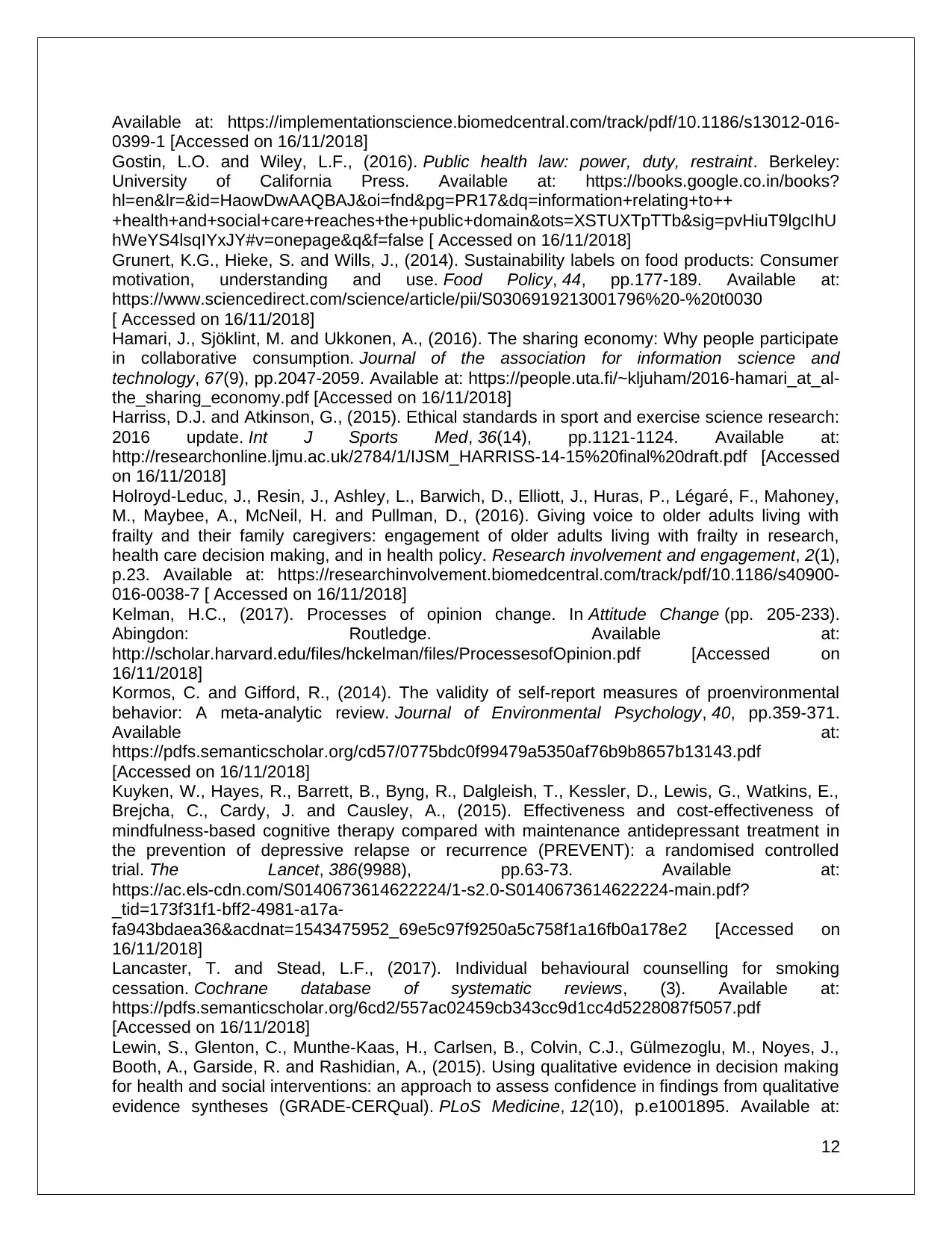
Available at: https://implementationscience.biomedcentral.com/track/pdf/10.1186/s13012-016-
0399-1 [Accessed on 16/11/2018]
Gostin, L.O. and Wiley, L.F., (2016). Public health law: power, duty, restraint. Berkeley:
University of California Press. Available at: https://books.google.co.in/books?
hl=en&lr=&id=HaowDwAAQBAJ&oi=fnd&pg=PR17&dq=information+relating+to++
+health+and+social+care+reaches+the+public+domain&ots=XSTUXTpTTb&sig=pvHiuT9lgcIhU
hWeYS4lsqIYxJY#v=onepage&q&f=false [ Accessed on 16/11/2018]
Grunert, K.G., Hieke, S. and Wills, J., (2014). Sustainability labels on food products: Consumer
motivation, understanding and use. Food Policy, 44, pp.177-189. Available at:
https://www.sciencedirect.com/science/article/pii/S0306919213001796%20-%20t0030
[ Accessed on 16/11/2018]
Hamari, J., Sjöklint, M. and Ukkonen, A., (2016). The sharing economy: Why people participate
in collaborative consumption. Journal of the association for information science and
technology, 67(9), pp.2047-2059. Available at: https://people.uta.fi/~kljuham/2016-hamari_at_al-
the_sharing_economy.pdf [Accessed on 16/11/2018]
Harriss, D.J. and Atkinson, G., (2015). Ethical standards in sport and exercise science research:
2016 update. Int J Sports Med, 36(14), pp.1121-1124. Available at:
http://researchonline.ljmu.ac.uk/2784/1/IJSM_HARRISS-14-15%20final%20draft.pdf [Accessed
on 16/11/2018]
Holroyd-Leduc, J., Resin, J., Ashley, L., Barwich, D., Elliott, J., Huras, P., Légaré, F., Mahoney,
M., Maybee, A., McNeil, H. and Pullman, D., (2016). Giving voice to older adults living with
frailty and their family caregivers: engagement of older adults living with frailty in research,
health care decision making, and in health policy. Research involvement and engagement, 2(1),
p.23. Available at: https://researchinvolvement.biomedcentral.com/track/pdf/10.1186/s40900-
016-0038-7 [ Accessed on 16/11/2018]
Kelman, H.C., (2017). Processes of opinion change. In Attitude Change (pp. 205-233).
Abingdon: Routledge. Available at:
http://scholar.harvard.edu/files/hckelman/files/ProcessesofOpinion.pdf [Accessed on
16/11/2018]
Kormos, C. and Gifford, R., (2014). The validity of self-report measures of proenvironmental
behavior: A meta-analytic review. Journal of Environmental Psychology, 40, pp.359-371.
Available at:
https://pdfs.semanticscholar.org/cd57/0775bdc0f99479a5350af76b9b8657b13143.pdf
[Accessed on 16/11/2018]
Kuyken, W., Hayes, R., Barrett, B., Byng, R., Dalgleish, T., Kessler, D., Lewis, G., Watkins, E.,
Brejcha, C., Cardy, J. and Causley, A., (2015). Effectiveness and cost-effectiveness of
mindfulness-based cognitive therapy compared with maintenance antidepressant treatment in
the prevention of depressive relapse or recurrence (PREVENT): a randomised controlled
trial. The Lancet, 386(9988), pp.63-73. Available at:
https://ac.els-cdn.com/S0140673614622224/1-s2.0-S0140673614622224-main.pdf?
_tid=173f31f1-bff2-4981-a17a-
fa943bdaea36&acdnat=1543475952_69e5c97f9250a5c758f1a16fb0a178e2 [Accessed on
16/11/2018]
Lancaster, T. and Stead, L.F., (2017). Individual behavioural counselling for smoking
cessation. Cochrane database of systematic reviews, (3). Available at:
https://pdfs.semanticscholar.org/6cd2/557ac02459cb343cc9d1cc4d5228087f5057.pdf
[Accessed on 16/11/2018]
Lewin, S., Glenton, C., Munthe-Kaas, H., Carlsen, B., Colvin, C.J., Gülmezoglu, M., Noyes, J.,
Booth, A., Garside, R. and Rashidian, A., (2015). Using qualitative evidence in decision making
for health and social interventions: an approach to assess confidence in findings from qualitative
evidence syntheses (GRADE-CERQual). PLoS Medicine, 12(10), p.e1001895. Available at:
12
0399-1 [Accessed on 16/11/2018]
Gostin, L.O. and Wiley, L.F., (2016). Public health law: power, duty, restraint. Berkeley:
University of California Press. Available at: https://books.google.co.in/books?
hl=en&lr=&id=HaowDwAAQBAJ&oi=fnd&pg=PR17&dq=information+relating+to++
+health+and+social+care+reaches+the+public+domain&ots=XSTUXTpTTb&sig=pvHiuT9lgcIhU
hWeYS4lsqIYxJY#v=onepage&q&f=false [ Accessed on 16/11/2018]
Grunert, K.G., Hieke, S. and Wills, J., (2014). Sustainability labels on food products: Consumer
motivation, understanding and use. Food Policy, 44, pp.177-189. Available at:
https://www.sciencedirect.com/science/article/pii/S0306919213001796%20-%20t0030
[ Accessed on 16/11/2018]
Hamari, J., Sjöklint, M. and Ukkonen, A., (2016). The sharing economy: Why people participate
in collaborative consumption. Journal of the association for information science and
technology, 67(9), pp.2047-2059. Available at: https://people.uta.fi/~kljuham/2016-hamari_at_al-
the_sharing_economy.pdf [Accessed on 16/11/2018]
Harriss, D.J. and Atkinson, G., (2015). Ethical standards in sport and exercise science research:
2016 update. Int J Sports Med, 36(14), pp.1121-1124. Available at:
http://researchonline.ljmu.ac.uk/2784/1/IJSM_HARRISS-14-15%20final%20draft.pdf [Accessed
on 16/11/2018]
Holroyd-Leduc, J., Resin, J., Ashley, L., Barwich, D., Elliott, J., Huras, P., Légaré, F., Mahoney,
M., Maybee, A., McNeil, H. and Pullman, D., (2016). Giving voice to older adults living with
frailty and their family caregivers: engagement of older adults living with frailty in research,
health care decision making, and in health policy. Research involvement and engagement, 2(1),
p.23. Available at: https://researchinvolvement.biomedcentral.com/track/pdf/10.1186/s40900-
016-0038-7 [ Accessed on 16/11/2018]
Kelman, H.C., (2017). Processes of opinion change. In Attitude Change (pp. 205-233).
Abingdon: Routledge. Available at:
http://scholar.harvard.edu/files/hckelman/files/ProcessesofOpinion.pdf [Accessed on
16/11/2018]
Kormos, C. and Gifford, R., (2014). The validity of self-report measures of proenvironmental
behavior: A meta-analytic review. Journal of Environmental Psychology, 40, pp.359-371.
Available at:
https://pdfs.semanticscholar.org/cd57/0775bdc0f99479a5350af76b9b8657b13143.pdf
[Accessed on 16/11/2018]
Kuyken, W., Hayes, R., Barrett, B., Byng, R., Dalgleish, T., Kessler, D., Lewis, G., Watkins, E.,
Brejcha, C., Cardy, J. and Causley, A., (2015). Effectiveness and cost-effectiveness of
mindfulness-based cognitive therapy compared with maintenance antidepressant treatment in
the prevention of depressive relapse or recurrence (PREVENT): a randomised controlled
trial. The Lancet, 386(9988), pp.63-73. Available at:
https://ac.els-cdn.com/S0140673614622224/1-s2.0-S0140673614622224-main.pdf?
_tid=173f31f1-bff2-4981-a17a-
fa943bdaea36&acdnat=1543475952_69e5c97f9250a5c758f1a16fb0a178e2 [Accessed on
16/11/2018]
Lancaster, T. and Stead, L.F., (2017). Individual behavioural counselling for smoking
cessation. Cochrane database of systematic reviews, (3). Available at:
https://pdfs.semanticscholar.org/6cd2/557ac02459cb343cc9d1cc4d5228087f5057.pdf
[Accessed on 16/11/2018]
Lewin, S., Glenton, C., Munthe-Kaas, H., Carlsen, B., Colvin, C.J., Gülmezoglu, M., Noyes, J.,
Booth, A., Garside, R. and Rashidian, A., (2015). Using qualitative evidence in decision making
for health and social interventions: an approach to assess confidence in findings from qualitative
evidence syntheses (GRADE-CERQual). PLoS Medicine, 12(10), p.e1001895. Available at:
12
⊘ This is a preview!⊘
Do you want full access?
Subscribe today to unlock all pages.

Trusted by 1+ million students worldwide
1 out of 13
Related Documents
Your All-in-One AI-Powered Toolkit for Academic Success.
+13062052269
info@desklib.com
Available 24*7 on WhatsApp / Email
![[object Object]](/_next/static/media/star-bottom.7253800d.svg)
Unlock your academic potential
Copyright © 2020–2025 A2Z Services. All Rights Reserved. Developed and managed by ZUCOL.





